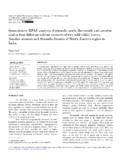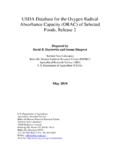Transcription of Antioxidant Properties of the Methanol Extracts of …
1 ORIGINAL ARTICLE The article was published by Academy of Chemistry of Globe Publications Published 01/13/2009 EISSN:1307-6167 Rec. Nat. Prod. 3:1 (2009) 23-31 Antioxidant Properties of the Methanol Extracts of the Leaves and Stems of Celtis africana Adeolu A. Adedapo1*, Florence O. Jimoh2, Anthony J. Afolayan2 and Patrick J. Masika3 1 Department of Veterinary Physiology, Biochemistry and Pharmacology, University of Ibadan, Nigeria. 2 Department of Botany, University of Fort Hare, Alice 5700, South Africa.
2 3 ARDRI, University of Fort Hare, Alice 5700, South Africa. (Received September 11, 2008; Revised October 27, 2008; Accepted October 28, 2008) Abstract:The Antioxidant activities of the Methanol Extracts from the leaves and stems of Celtis africana (Ulmaceae) were assessed in an effort to validate the medicinal potential of the subterranean part of the herb. The Antioxidant activity and phenolic contents of the stem as determined by the DPPH, proanthocyanidins, total phenols, the flavonoids, and total flavonols were higher than that of the leaves.
3 On the other hand, the FRAP contents of the leaves were higher than that of the stem. The ABTS scavenging activities of both the stem and leaves were similar and comparable to that of BHT, the standard Antioxidant used. This study, has to some extent, validated the medicinal potential of the leaves and stems of Celtis africana. Keywords: Celtis africana; free radical scavenging activity ; polyphenols; reducing capacity. 1. Introduction Free radicals which have one or more unpaired electrons are produced in normal or pathological cell metabolism.
4 Reactive oxygen species (ROS) react easily with free radicals to become radicals themselves. ROS are various forms of activated oxygen, which include free radicals such as superoxide anion radicals ( ) and hydroxyl radicals (OH.), as well as non-free radical species (H2O2) and the singled oxygen (1O2) [1, 2, 3, 4]. Also, excessive generation of ROS, induced by various stimuli and which exceed the Antioxidant capacity of the organism, leads to a variety of pathophysiological processes such as inflammation, diabetes, genotoxicity, and cancer [5, 6, 7].
5 *Corresponding author: Email: Phone: +234 802 3928 512. Antioxidant activity of Celtis africana 24 Exogenous sources of free radicals include tobacco smoke, ionizing radiation, certain pollutants, organic solvents, and pesticides [3, 8, 9, 10]. Therefore, ROS can cause lipid peroxidation in foods, leading to their deterioration. In addition, these ROS can easily initiate the peroxidation of membrane lipids, leading to the accumulation of lipid peroxidation.
6 The peroxidation products and their secondary oxidation products such as malondialdehyde and 4-hydroxyinonenal can react with biological substrates such as protein, amines, and deoxyribonucleic acid [7, 11]. As a result of this, much attention has been focused on the use of antioxidants , especially natural antioxidants to inhibit lipid peroxidation and to protect from damage due to free radicals. A great number of aromatic and other medicinal plants contain chemical compounds that exhibit Antioxidant Properties .
7 Sources of natural antioxidants are primarily, plant phenolics that may occur in all parts of plants such as fruits, vegetables, nuts, seeds, leaves, roots and barks [12, 13]. Celtis africana (Ulmaceae) is a medium-sized tree whose trunk is usually single and upright; its crown is broadly upright or rounded; the foliage is dark green or yellowish green in diseased trees [14]. C. africana is common and widespread in South Africa. It occurs in a wide range of habitats from the coast up to 2100 cm, from the Cape Peninsula northwards through South Africa to Ethiopia, where it grows in dense forest, on rocky outcrops, in bushveld, in open grass, on mountain slopes, on coastal dunes, along river banks, and in kloofs [14, 15, 16, 17, 18, 19, 20].
8 The leaves are eaten by cattle and other domestic animals [14]. The bark of C. africana is also known to be a seasonal food for the Red Colobus monkey [21]. The wood of Celtis africana is white to yellowish in colour and of medium hardness. It is tough and strong, and polishes well, but is difficult to work. It is a good general timber suitable for making planks, shelving, yokes, tent-bows and furniture. The African people have always used it to make a variety of household articles. It is also thought to have magical Properties .
9 The wood is mixed with crocodile fat as a charm against lightning, and many people believe that it has the power over evil and that pegs of wood driven into the ground will keep witches away [15]. The family Ulmaceae is most often treated as a single family with two subfamilies: Ulmeae and Celteae. A flavonoid survey of 80 species of Ulmaceae shows that each of the 19 genera in the survey was characterized by the production of flavonols (Ulmoid) or glycoflavones (Celtoid), but not both [22].
10 In this paper, we present the results of the Antioxidant activities of Methanol Extracts of the leaves and stems of C. africana. The findings from this work may add to the overall value of the medicinal potential of the herb. 2. Materials and Methods Plant collection Both the stems and leaves of the plant were collected in July 2006 from the Eastern Cape Province of South Africa. The area falls within the latitudes 30 00-34 15 S and longitudes 22 45 -30 15 E.



